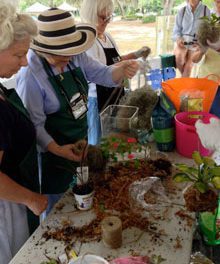 Who can resist being outside this time of year? I’m sitting on my deck enjoying a delightful breeze off the marsh and admiring the garden. To top it off, there’s a Painted Bunting at the bird feeder – what more could one ask for? The flowers are blooming, the temperature is rising, but we still have time to add color or make changes if desired.
Who can resist being outside this time of year? I’m sitting on my deck enjoying a delightful breeze off the marsh and admiring the garden. To top it off, there’s a Painted Bunting at the bird feeder – what more could one ask for? The flowers are blooming, the temperature is rising, but we still have time to add color or make changes if desired.
The cool season pansies and snapdragons are fading and those decorative cabbages and kale are getting leggy; it is time to pull them out and replace them with some heat tolerant plants and/or bulbs. The garden centers are chock full of bright offerings right now. The annuals, generally good for only one season, make good fillers and container plants that can be easily changed out. Perennials, those plants that return each year, are a good choice for a more permanent planting. With proper care, you will have many years of color without having to replace the material each year. A few long blooming sun lovers that we don’t see enough of would be the orangey Firebush, Hamelia patens or Yellow Bells, Tecoma Stans. Hummingbirds and butterflies love these bright flowers also. For shady spots, consider Aspidistera or Cast Iron Plant; the newer variegated varieties come with stripes, spots and I even have one with both stripes and spots on the same leaves. These are excellent substitutions for hostas, which can be fussy in our growing conditions. Japanese Painted and New Zealand Holly Ferns have both proven to be real workhorses in the shady garden, providing texture and color. The elephant ears are popular right now, but use caution; some of these can become invasive (guess how I know) and will keep you busy yanking them out for years to come. A hardy hibiscus from Plant Delights Nursery recently caught my eye. Forget the old Rose of Sharon, some of these tough new plants can rival the brightest tropical hibiscus and they get bigger and better each year.
If you haven’t already pruned your azaleas, you still have a few weeks to do so. If your Southern Indica Azaleas like the lovely George Lindley Tabor, with its pinkish lavender flowers, need a haircut, you can easily shape them with hand clippers. Using a hedge trimmer gives a hard, unnatural looking line that mars the graceful beauty of these plants. Older plants sometimes need rejuvenating, and that’s when you can give them a hard trim back to about 12”. More information on this can be found at: http://www.clemson.edu/extension/hgic/plants/landscape/shrubs/hgic1059.html
Recently I was listening to a program from the University of Florida on the care of Palmetto trees. It seems many of us have been over trimming them, too. It is actually harmful to the tree’s health to take off too much foliage. To maintain the vigor, only remove the very oldest leaves and the “inflorescences,” those flowering/fruiting stems. You want to maintain a full round head of foliage, including some brownish leaves, for maximum health.
Keep up with your fertilizing; growing plants, like growing children, need good nutrition to do their best. And keep an eye out for pests and disease. The Master Gardeners at the Port Royal Farmer’s Market on Saturday mornings can help to identify and give you treatment ideas for garden problems.
Water new plantings well until they are established, but if you have done your homework and put the right plant in the right spot, they will thrive with minimal care for the rest of the season.
And, remember, it’s Springtime… so get out there and dig.
Regional Gardening Events
Sumter, SC, The Iris Festival at Swan Lake, For further information: http://www.sumtersc.gov/VisitingUs/Festivals_Iris.aspx
May 29th, Monarch Butterfly Release at Brookgreen Gardens, Pawley’s Island, SC For more information: www.brookgreen.org
June 6th – 10th Garden A Day sponsored by the Beaufort Garden Club. Watch this newspaper for further details.
Read more How Does Your Garden Grow







